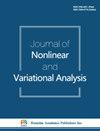Fast spectral clustering with self-weighted features
IF 1.9
2区 数学
Q1 MATHEMATICS
引用次数: 3
Abstract
. As one of the mainstream clustering methods, the spectral clustering has aroused more and more attention recently because of its good performance, especially in nonlinear data sets. However, traditional spectral clustering models have high computational complexity. Meanwhile, most of these models fail in distinguishing the noisy and useful features in practice, which leads to the limitation of clustering performance. In this paper, we propose a new fast spectral clustering with self-weighted features (FSCSWF) to achieve good clustering performance through learning and assigning optimal weights for features in a low computational complexity. Specifically, the FSCSWF selects anchors from original samples, then learns the weights of features and the similarity between anchors and samples interactively in a local structure learning framework. This interactive learning makes the learnt similarity can better measure the relationship between anchors, and samples due to the optimal weights make the data points become more discriminative. Moreover, the connectivity constraint are embedded to make sure that the connected components of bipartite graph constructed by the learnt similarity can indicate clusters di-rectly. In this way, the FSCSWF can achieve good clustering performance and has a low computational complexity, which is linear to the number of samples. Extensive experiments on synthetic and practical data sets illustrate the effectiveness and efficiency of the FSCSWF with respect to state-of-the-art methods.基于自加权特征的快速光谱聚类
. 谱聚类作为主流聚类方法之一,近年来因其良好的性能,特别是在非线性数据集上的应用受到越来越多的关注。然而,传统的光谱聚类模型具有较高的计算复杂度。同时,在实际应用中,这些模型大多无法区分噪声特征和有用特征,从而限制了聚类性能。本文提出了一种新的自加权特征快速谱聚类方法(FSCSWF),通过对特征进行学习和分配最优权重,在较低的计算复杂度下获得良好的聚类性能。具体而言,FSCSWF从原始样本中选择锚点,然后在局部结构学习框架中交互学习特征权重和锚点与样本之间的相似度。这种交互学习使得学习到的相似度可以更好的衡量锚点之间的关系,而样本由于最优的权重使得数据点变得更有判别性。此外,该方法还嵌入了连通性约束,以保证由学习到的相似度构造的二部图的连通分量能够直接表示聚类。这样,FSCSWF可以获得良好的聚类性能,并且具有较低的计算复杂度,计算复杂度与样本数量呈线性关系。在合成和实际数据集上进行的大量实验表明,相对于最先进的方法,FSCSWF的有效性和效率。
本文章由计算机程序翻译,如有差异,请以英文原文为准。
求助全文
约1分钟内获得全文
求助全文

 求助内容:
求助内容: 应助结果提醒方式:
应助结果提醒方式:


